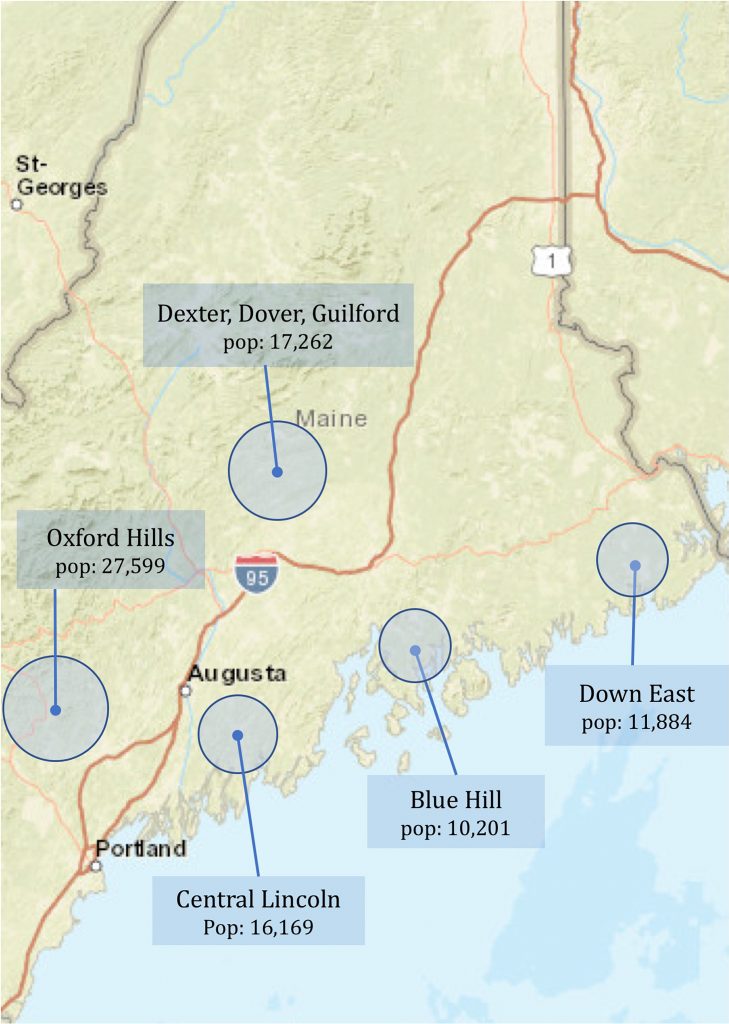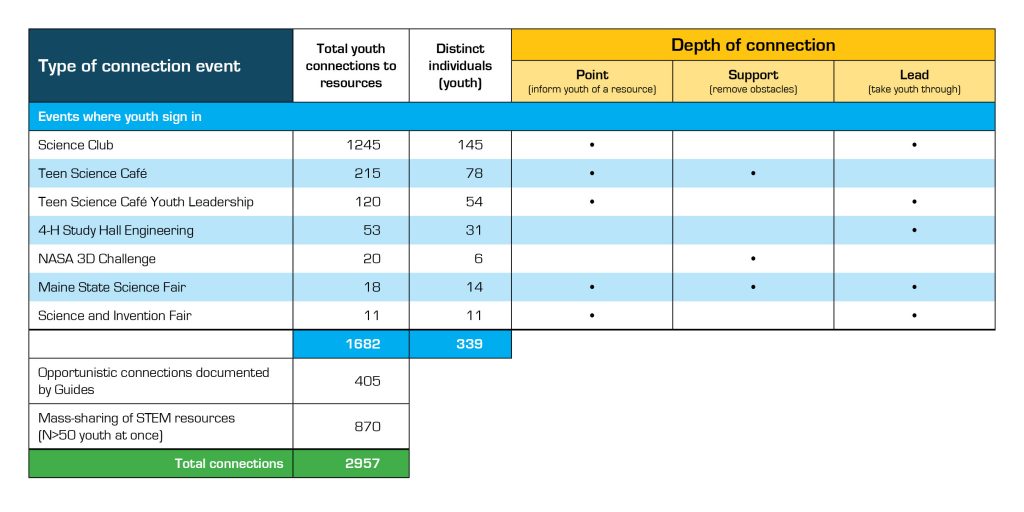Diversity and Equity
Facilitating Formal–Informal Connections in Rural STEM Ecosystems
Connected Science Learning May-July 2017 (Volume 1, Issue 3)
By Jan Mokros, Jennifer Atkinson, Sue Allen, Alyson Saunders, and Kate Kastelein
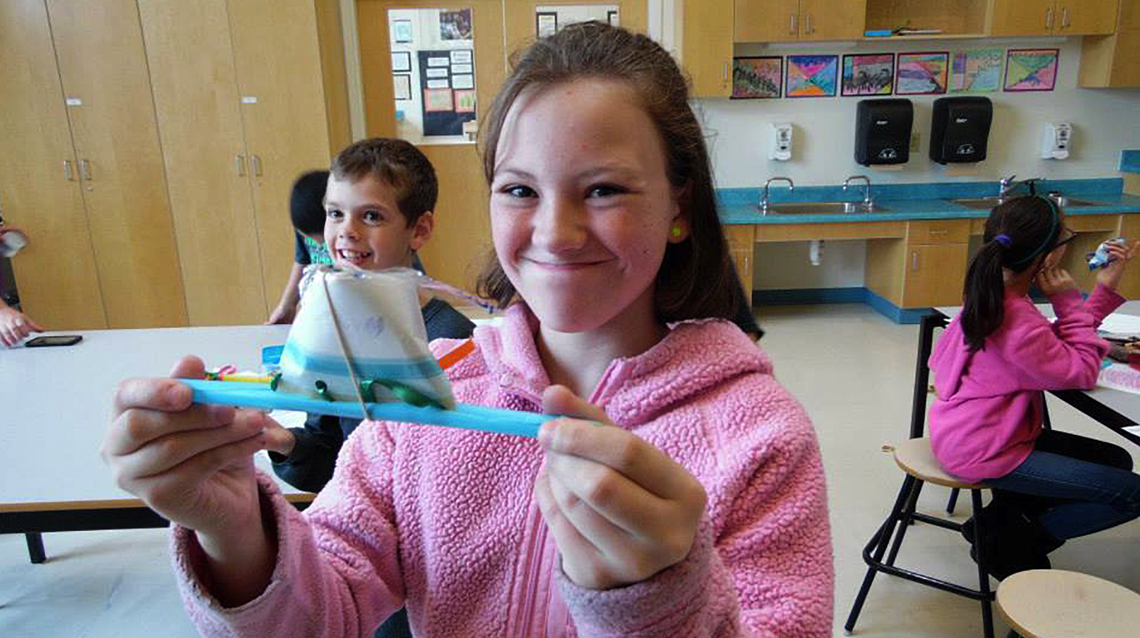
“STEM Guides” serve as human brokers to connect 10- to 18-year-old youth from rural Maine in STEM education opportunities that already exist in their communities, including after-school programs, clubs, camps, library activities, special events, contests, and competitions.
The idea of “STEM (science, technology, engineering, and math) learning ecosystems” is becoming increasingly popular as a way to describe what researchers and practitioners do to “provide the architecture for cross-sector learning, offering all young people access to STEM-rich learning environments” (STEM Funders Network 2017). STEM ecosystems involve active collaboration among schools, out-of-school programs, libraries, businesses, universities, and related organizations.
In large urban settings, such connectivity is often provided by informal science institutions or city-based after-school programs that provide under one umbrella a range of STEM offerings, such as field trips, guest speakers, public events, family programs, and community gatherings. Well-connected institutions may even provide links to other organizations instead of seeing them as competitors. But what do such ecosystems look like in rural areas, where there are many natural and community resources but few informal STEM institutions? Although some might view these rural learning ecosystems as “STEM-poor,” we propose that the existing resources tend to be overlooked because the ecosystem lacks connectivity.
In this article we describe a model designed for rural settings that uses community-based “STEM Guides” as human brokers to engage isolated 10- to 18-year-old youth in STEM. The STEM Guides connect youth with opportunities that already exist in their communities, including after-school programs, clubs, camps, library activities, special events, contests, and competitions. STEM Guides also introduce youth and their families to virtual opportunities, such as citizen science monitoring, and statewide experiences, such as the Maine State Science Fair.
The goal of the project is to help youth and their families find and engage with STEM resources they may not be aware of and reduce any obstacles to participation. STEM Guides rely on their existing community connections to engage youth and lead them to new experiences. For this reason, STEM Guides serve relatively small geographic regions (of less than 10 small towns), where they live and know a wide range of local residents and institutions (e.g., as retired librarians, former teachers, providers of well-respected community activities). We are working with five small Maine STEM Hubs, whose locations are shown in Figure 1.
Ideally, rural STEM Guides have three key roles in their learning ecosystems:
- Working with the community’s youth and their families to make them aware of, and engage with, STEM resources that are accessible to them. Accessible resources are ones that are available to low-income families without their having to travel long distances. These resources may include: local resources (e.g., programs at or after school, nearby summer programs); online resources (e.g., STEM games, citizen science projects, online activity sites) using connectivity at home, school, or local libraries; and local STEM professionals who may not even self-identify as such (e.g., medical personnel, vets, organic farmers).
- Gradually building a STEM asset map, or Resource Guide, of their community’s resources. These resources are posted to a statewide online database called the Maine STEM Resource Bank, which is powered by a national STEM database called The Connectory.
- Working with partner organizations, such as the University of Maine Cooperative Extension: 4-H Program, schools, libraries, and branches of universities, to make local STEM-related resources more visible, networked, and accessible. Guides typically convene local networks so that everyone knows about each other’s work.
STEM Guides in Practice
The five STEM Hubs span a variety of small regions, from forest-based to fishing-based, from fairly close to a university to quite remote. All include a group of towns and schools, with a total population of 10,000 to 28,000. The median household income in each case is lower than Maine’s median household income of $47,000 (U.S. Census Bureau 2014).
STEM Guides launched with National Science Foundation funding in 2013 after two years of pilot testing, which indicated that youth access to out-of-school STEM in rural areas could be improved through personal brokering. When we began the STEM Guides Project, we hoped to involve a large number of volunteers who could share responsibilities and enjoy the camaraderie of working together. However, we were unable to find community members willing to volunteer for more than about 10–15 hours a year. We therefore turned to an employment model, hiring Guides at an hourly salary rate that is modest yet competitive with that of other skilled part-time workers in the area. Typically, two types of community residents have gravitated toward these positions: retired or semiretired professionals and long-term residents, including teachers or former teachers and community development professionals. By definition, Guides must have enthusiasm for STEM, although many of them have no formal training in STEM fields. For example, one STEM Guide was a former librarian who had also run a local inn, and another Guide was a former documentary filmmaker. We have found that Guides also benefit from being well-known and well-respected in their communities, particularly in roles that already position them as facilitators of engaging experiences (e.g., organizing the annual school musical, running a local club).
The Guides are supported and coached by STEM education specialists from the Maine Mathematics and Science Alliance (MMSA). MMSA staff check in at least biweekly and engage Guides in professional development on a quarterly basis. Guides may also participate in special workshops held by the project’s partners (e.g., 4-H Program sessions on positive youth development, and the Teen Science Café Network’s annual meetings.)
How the System Works: The Story of One Hub
The longest-standing Hub, known as DDG (the initials of the Hub’s three major towns of Dexter, Dover–Foxcroft, and Guilford), has been active for more than three years and is moving from grant support to sustaining itself with school and community resources. We offer this Hub as a case study because it has been operating for the longest time. We have the most data on it and it best illustrates the essential characteristics of the STEM Hub model.
The DDG area is in many ways like other poor rural areas in Maine. It has been losing residents for 15 years due to the loss of many manufacturing jobs. The small towns in the DDG area were once a center for shoe manufacturing and lumbering. The service industry, including tourism, is now the source of most jobs. The median household income in the towns ranges from $31,000 to $38,000, which is well below the state’s median household income (U.S. Census Bureau 2014). Only about 33% of adults in these communities are college graduates (U.S. Census Bureau 2014). Like most rural areas of Maine, the population is largely (93%) white. In DDG, major partner organizations include:
- University of Maine Cooperative Extension: 4-H Program, which hosted STEM-focused clubs. This organization also offered STEM programming during study halls at one of the schools.
- Thompson Free Library in Dover–Foxcroft, which offered STEM kits provided by Cornerstones of Science, a Maine-based project partner. This library also offered an Hour of Code program.
- the school districts’ Summer Food Service Program, which offered U.S. Department of Agriculture–funded free lunches to youth in the area. We partnered with this free lunch site to offer a STEM summer program (see below).
- Piscataquis Soil and Water Conservation District, which involved youth in their Teen Wildnerness Expeditions and forestry programs.
- amateur astronomers, who involved youth in star parties.
STEM Guides’ work in DDG started with a community launch that brought together parents, teachers, business people, and STEM professionals to describe the new project and acquaint STEM-interested people with each other. A Facebook page was established, and it became a primary vehicle for sharing STEM events with parents in a timely way. Interestingly, youth themselves were not regular users of Facebook or e-mail, so Guides communicated with them by phone, text, or in person. Not surprisingly, parents of middle school students were the primary communicators with the Guides, whereas parents of high school students took on more of a supporting role.
Like other youth workers, the Guides met individually with 10- to 18-year-old youth (and sometimes with parents), interviewed them about their STEM interests, showed them the online STEM Resource Bank, and empowered them to connect to local STEM resources that would spark or deepen their STEM interests. Meetings took place in public places, including schools, which offered space to the Guides. Fifty-one such meetings were conducted over three years, but they never became runaway successes in the Hub; we had to encourage families to interview, and they only very rarely came back to the STEM Guide to ask about “next steps” in a STEM trajectory.
We began to reach out to youth in more assertive ways through school and community events (e.g., school fairs, activity nights, open houses, regional festivals), as well as through teachers and librarians. We found teachers, including substitute teachers, to be enormously helpful in recruiting students, providing referrals, and occasionally working directly with students to connect them with new STEM resources.
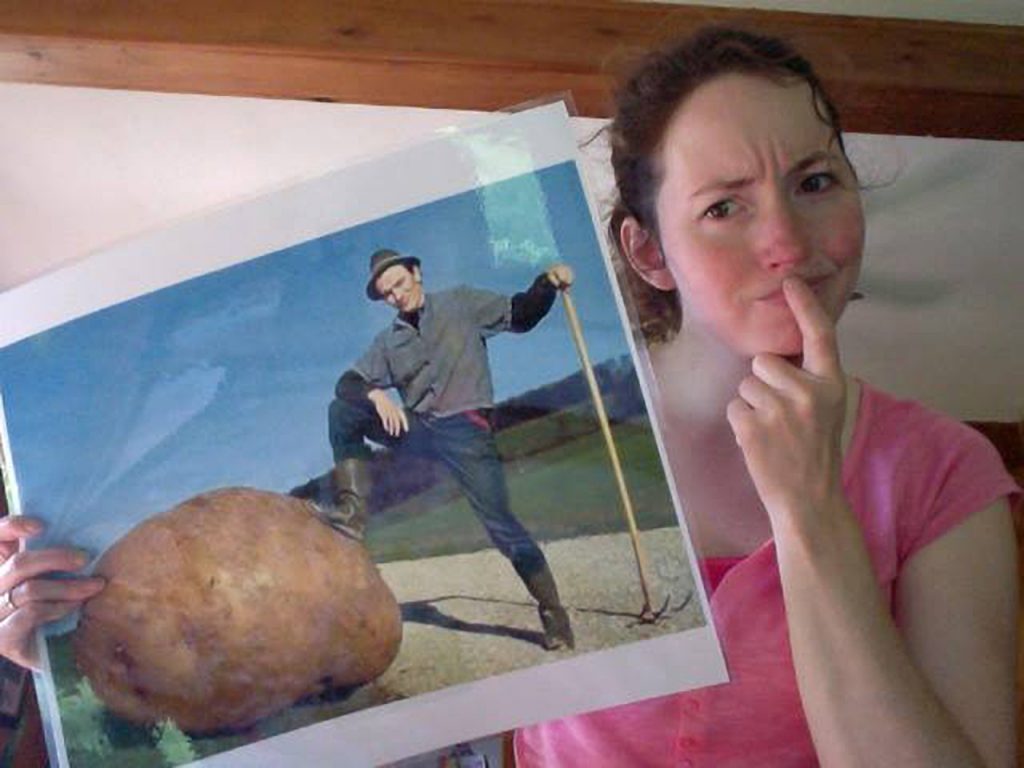
With more frequent access to students, the Guides encouraged them to attend STEM clubs, summer camps, and other programs, such as those offered by the University of Maine Cooperative Extension: 4-H Program. STEM Guides also directed students to resources such as the telescopes, microscope kits, and 3-D printers available through libraries.
As much as possible, we avoided inventing new offerings, but Guides did set up clubs and events that gave youth access to existing high-quality programs created elsewhere. These “STEM gift packages” were created by institutions with track records for providing high-quality STEM materials. For example, we offered a summer program that used an out-of-school kit designed by the Boston Museum of Science as part of its Engineering Is Everywhere (EE) initiative. This program included students who were already participating in a free lunch program over the summer. The program used EE’s “Pandemic” module for middle school students, reached a dozen youth, was free, and was easy to implement by those who were not STEM experts.
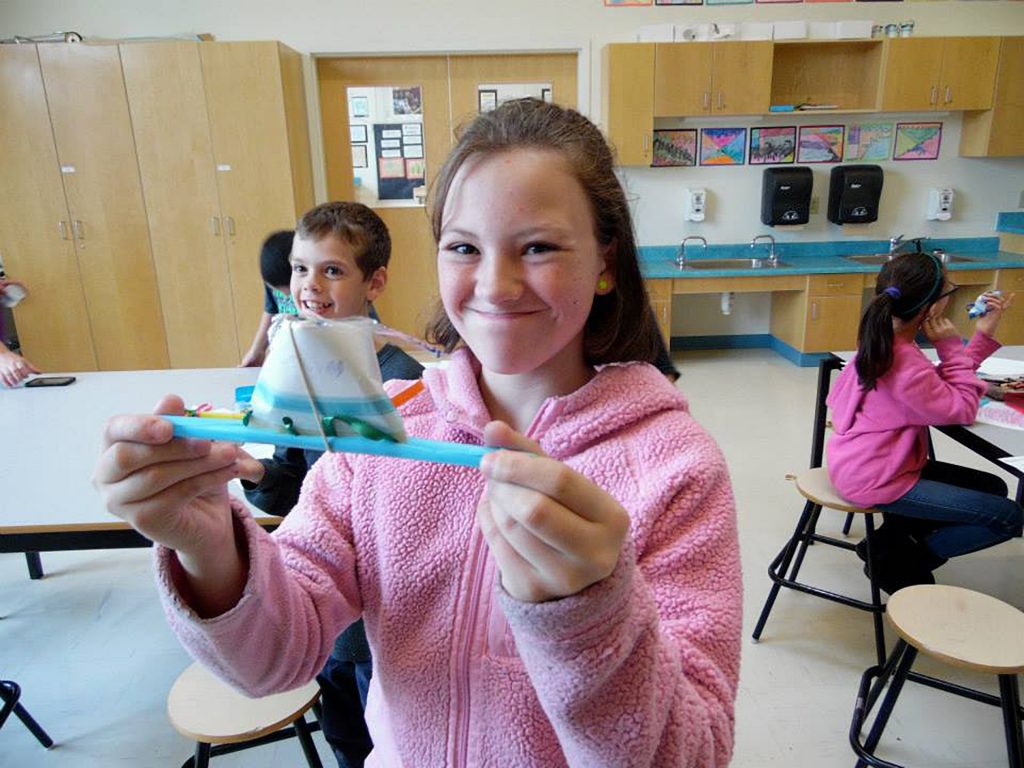
During the Hub’s second year, one of the STEM Guides established a science club for middle school students. After-school STEM clubs were particularly needed because there were no other STEM-related school-based clubs for fifth through eighth graders and, as a result, no easy way for kids to find or gain access to well-developed, nationally prominent STEM programs and activities. The strong desire for such clubs was evidenced by their oversubscription and the repeat involvement of many students. Nine science clubs, serving 15–35 students each, were implemented during the project’s first three years. The clubs connected youth to high-quality activities from www.howtosmile.org (a well-used STEM gift package), sent activity guides home so students could share their experiences with family and friends, and pointed participants to additional STEM resources they might follow up with to explore certain topic areas.
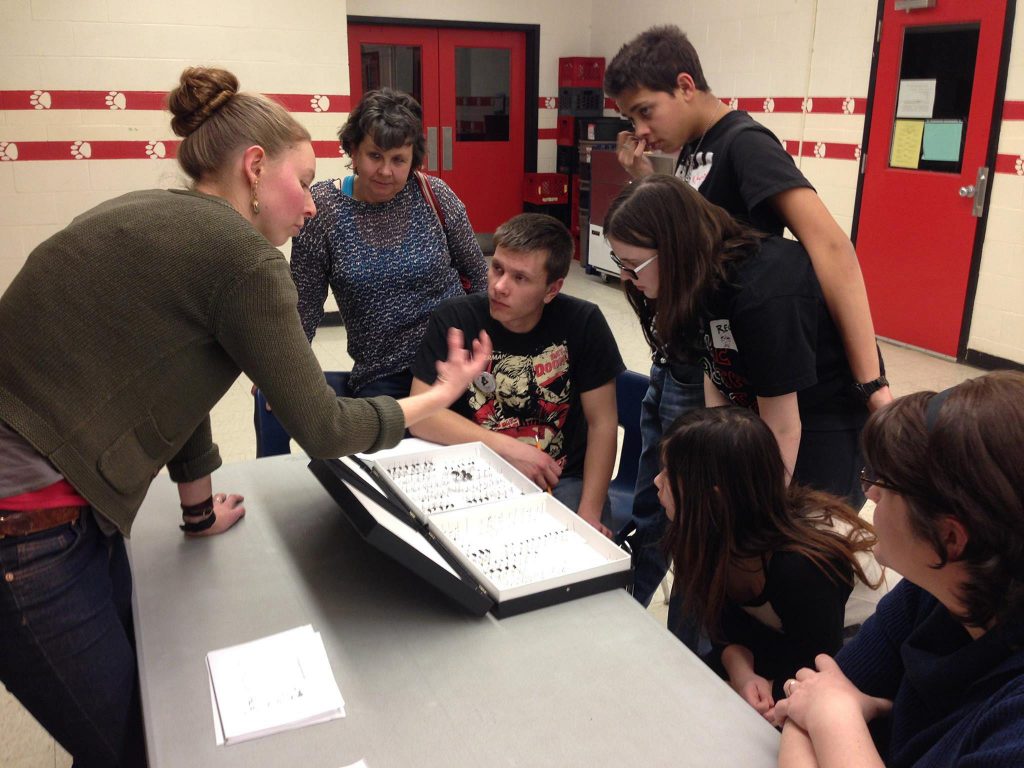
For high school–age youth some science-related opportunities already existed and were close at hand (e.g., school math team, chess club). Summer programs at the main campus of the University of Maine, located more than an hour’s drive south near Bangor, were also already available. The latter, however, were inaccessible to most families and the former did not provide meaningful connections to local STEM professionals, resources, or organizations. Therefore, we introduced Teen Science Cafés. This program, a STEM resource with detailed implementation instructions available online, is designed to provide community teens with opportunities to connect to local scientists whom they may not know. For example, one café covered sustainable agriculture and featured a panel of local experts (e.g., organic and dairy farmers, biomass fuel entrepreneurs, biological pest control experts). The teens led a roundtable discussion with attendees and served a dinner they had prepared from locally sourced ingredients. Over three years, Teen Science Cafés in DDG were able to connect 78 youth to local scientists.
During the third year of the program, a STEM Guide worked with a high school teacher (and former STEM Guide) to encourage and support high school students’ participation in the Maine State Science Fair (MSSF). Seven students met with the Guide after school over a period of several months to develop research and engineering projects for the MSSF. This was the first time that students from one of the DDG towns had participated in the fair, and one of them placed second in the computer science category. The STEM Guide and the science teacher also arranged for a group of students to attend the science fair as observers, in anticipation of recruiting them as participants in future years.
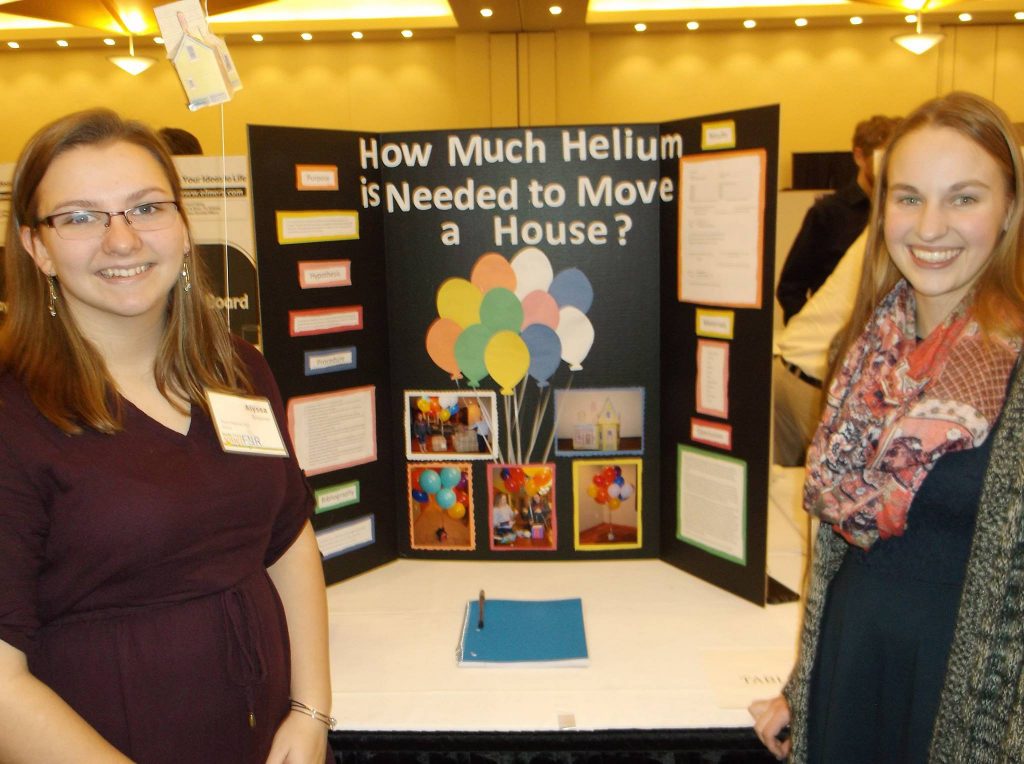
As grant funding ended, the Guides worked with the community to develop a sustainability plan. Following an outpouring of public support and thanks to four months of work by the dedicated STEM Guides, $2,500 was secured through the school district to continue the science clubs for middle school students. In addition, $2,500 was raised from local donations via face-to-face outreach and an online funding platform. A new STEM Boosters club has also formed to lead annual fundraising and advocacy efforts. A recent in-kind contribution from the project’s partner, the University of Maine’s Cooperative Extension: 4-H Program, has additionally extended the nationally acclaimed Tech Wizards program to the DDG area. This program will involve underserved youth in after-school programs in robotics, website design, and geographic information systems.
Counting and Characterizing Connections Within the Hub Ecosystem
One of our greatest evaluation challenges was tracking the individual learning trajectories of youth, a key outcome of our model. We hoped to document the many STEM connections that led individual youth toward a growing interest in one or more STEM topics, but in practice, we found that many of our partners did not have participation data at the level of individuals for small, informal learning experiences, or could only give us total attendance numbers due to privacy guidelines in their own programs. At the same time, our attempts to contact families directly to gather data were met with low response rates and often a misunderstanding of the STEM Guide’s role as merely the one running a particular event or program. For higher-quality data, we relied on the Guides themselves to count and categorize their work with youth. The Guides used two systems: one that tracked participation through sign-in sheets and noted which youth followed up on specific resources, and a second that simply counted participant totals. Table 1 summarizes the data we collected using both systems in the DDG Hub.
Figure 2
Characterization and Counts of Connections Made by STEM Guides Between Youth and STEM Resources, Based on Sign-In Sheets and Detailed Self-Reports (DDG Hub, 2014–2016)
- 78 youth attended an average of 2.8 Teen Science Cafés, resulting in 215 connections. During the cafés, the STEM Guide accompanied the youth as they engaged with local scientists, and at the end of each café, the Guide provided follow-up resources in the form of handouts.
- 14 youth went to 18 events related to the MSSF (including the Maine Science Festival). In most cases, the STEM Guide led youth through the creation of a project to present at the fair, accompanied them to the fair, and directed them to other projects and resources while at the Fair.
DDG STEM Guides made an additional 1,275 connections with youth over the three years of the project, mostly (870 connections) by sharing links to STEM resources with large groups of youth at school assemblies or community events. The remaining 405 connections reflected the STEM Guides’ creativity and initiative in reaching out to youth, based on their knowledge of youths’ particular interests. Examples include:
- e-mailing a student who loves technology to invite him to an upcoming Scratch Day (programming event) at the local library,
- posting an upcoming citizen science event to members of the science club and their parents,
- accompanying a girl interested in biology to a Humanities Council program on Darwin, and
- helping a group of interested parents find a summer camp for their STEM-interested youth.
Overall, we were pleased that the Guides managed to connect over 300 rural youth with at least one extended STEM experience and create almost 3,000 total connections (including through simple pointing, accompanying, and leading).
Conclusions
We have drawn several conclusions from the project that we find particularly interesting or surprising:
- Even when building purely informal STEM learning ecosystems, schools are uniquely able to provide access to youth, credibility, liability insurance, transportation options, individual data-tracking, and potential staff. Because our project was sponsored by the Advancing Informal STEM Learning Division of the National Science Foundation, we emphasized informal STEM resources and experiences for youth, and we involved schools primarily as ways to contact the youth. An advantage to this was that we were not subject to assessment pressures or performance expectations related to academic achievement. A disadvantage was that there was no easy way to track individual youth participation in community STEM events because there was no organizational body (such as a school district) tracking individual youth participation. Also, because we lacked the umbrella liability coverage of a school district, we had to go to great lengths to ensure liability coverage for the Guides through our home organization (MMSA). Fortunately, with the conclusion of AISL funding after three years, the program we started in DDG has been continued by a local school system that is deeply committed to out-of-school, year-round learning.
- Ecosystems involve competition, both real and perceived. Although some schools and teachers were receptive to the idea of enriching youth’s STEM learning with informal learning experiences, others were wary of the Guides, and some even considered them competitors for the time and interest of “their” students. Competition was also an issue from the family perspective, as many STEM-interested youth and their parents saw the community-based STEM events as competing for their time participating in activities such as after-school sports or clubs.
- Connecting youth to existing STEM resources is more complex and difficult than running STEM programs. We found it a constant uphill struggle to retain our mission as STEM connectors because community members and partners expected and wanted STEM programs. We thought raising awareness of local STEM resources would be seen as a valuable enterprise, but almost nobody responded to our multimedia offers to help families “find interesting and fun things to do in science, engineering, technology, or math.” We learned that youth needed much more active facilitation to really engage with available STEM resources. In many cases, Guides had to accompany or even lead youth through a resource, blurring the line between connector and provider.
Issues to Consider When Replicating a Rural STEM Hub
We end with three recommendations for anyone planning to create small regional STEM Hubs using human brokers such as STEM Guides:
- Choose a coherent region. Just because a STEM Hub is small does not guarantee that residents will go to STEM events in each other’s towns. In our rural context, we identified groups of towns or school districts whose families could reasonably drive to events or programs in neighboring towns. However, this presented challenges when the members of neighboring communities did not regularly associate with each other. In one case, an island community was adjacent to a larger town, but the bridge between the towns was perceived almost as a wall when it came to recruiting for community events. We recommend choosing regions that encompass mutually amicable towns and schools.
- Hire people who really understand the model. We have found that community members who expressed early interest in STEM Guide work have been most eager to work directly with youth, preferably doing hands-on activities. This part of the work has elicited some truly marvelous programming that lets youth experience STEM resources they might never have noticed (e.g., a star-party with an amateur astronomer, a Teen Science Café featuring a scientist from a local aquaculture organization). A larger part of the role is that of a community organizer: Much of the work involves frequent contact with partners and local organizations in flexible ways to create opportunities for youth over the long term. We have found that this second role is much more difficult to recruit for. In some Hubs, we have hired multiple part-time employees to help meet this range of needs.
- Early on, try to identify both an individual and an institutional champion. To date, we have found that our most successful STEM Hubs seem to rely on both individual and institutional champions. Individuals serving as STEM Guides provide caring and trusted connections to youth and families, a passion for STEM, and the initiative to create flexible partnerships and opportunities. However, they may leave the position due to factors such as their children developing other interests or leaving home, a better or more permanent job becoming available, or a gradual recognition of a mismatch between their personal goals and those of the STEM Hub. When such transitions happen, it is extremely helpful to have an institutional champion, such as a community-based organization, business, or school district, to support the hiring of a new Guide. As one STEM Guide put it, “My shift in thinking is that this is more than just a need to engage kids in STEM. We need to engage communities in a way that is beneficial to the school culture and the community culture. All of it is important. We really need to engage the public in a way that will help the school, the community, and benefit the economics of the area.”
Jan Mokros (jmokros@scieds.com) is senior research scientist at Science Education Solutions in Los Alamos, New Mexico. Jennifer Atkinson (jatkinson@mmsa.org) is a project manager at the Maine Mathematics and Science Alliance in Augusta, Maine. Sue Allen (sallen@mmsa.org) is a senior research scientist at the Maine Mathematics and Science Alliance in Augusta, Maine. Alyson Saunders (asaunders@aos94.org) is a science teacher at Dexter Regional High School in Dexter, Maine, and a former Lead STEM Guide at the Maine Mathematics and Science Alliance in Augusta, Maine. Kate Kastelein (kkastelein@mmsa.org) is a research associate at the Maine Mathematics and Science Alliance in Augusta, Maine.



